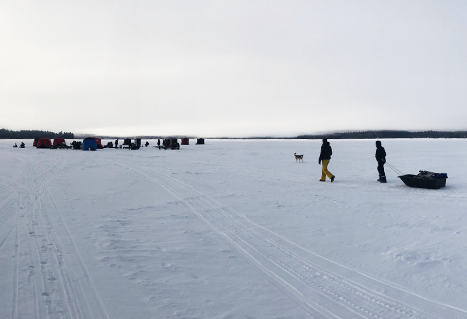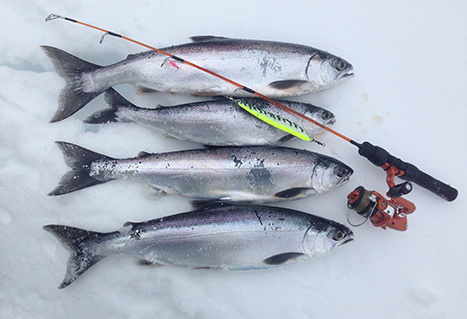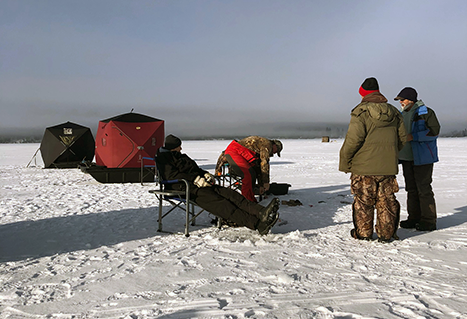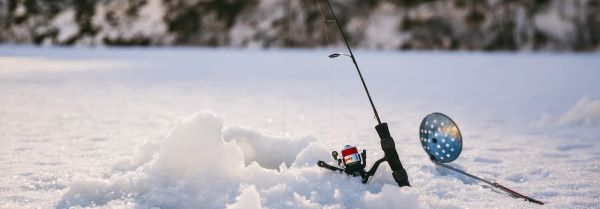Growing up in the Kootenays, kokanee fishing came naturally to me; I was always up at first light to catch that first bite. Later, as a young fisheries biologist, I was led to the Cariboo, where I learned that kokanee were caught through the ice as well – something brand new to me.
As a newbie to ice-fishing, I remember those first days: getting out before dawn to search for holes or evidence of fish caught the day before, and then at first light, setting up a sounder before settling down for a long day.
I also remember Harry and Ivan. While 20 to 30 people set up at the crack of dawn, they arrived an hour or two later. Both men were retired, and wore tattered old snowmobile suits. While Harry was quiet, he looked at you sternly like you owed him money. Ivan, on the other hand, talked endlessly and to everyone, barely seeming to care that he was even fishing. The first day I met them, they had drilled holes right beside me, commenting to each other (but I’m sure, directed at me), “This is where we were yesterday, right?” They each shot me a glance that dropped the temperature another five degrees. It didn’t matter that I was on “their” spot; they weren’t there half an hour before they had their five-fish limit each and were gone. I sat there for the next four hours before finally catching my limit, all the time wondering what has just happened. Well, every dog has its day, right? Wrong! Over the next two years of ice-fishing, every time I met Harry and Ivan, the results were exactly the same – those two limited out before everyone else…every time!
Over the next 10 years, Harry, Ivan, and I became good friends. And they revealed to me the best secret to fishing for kokanee through the ice that I have ever learned: success is neither a fluke nor random. Rather, success is the culmination of four factors: kokanee being around, attracting them to your lure, getting or knowing that you have a bite, and physically catching or landing them.

Most of these factors for a new ice fisherman are out of our control, or easily accounted for. No fish around? Painful as it may be, there’s nothing much you can do. Another location might be better, but no one ever really knows; it’s totally unpredictable. Attracting them in? Any heavy flasher (a large fishing spoon with hooks removed) will attract kokanee. I prefer a silver-plated flasher because the silver has a higher reflectivity of light than nickel. Since kokanee are naturally curious and feed on microscopic plankton, if you jig the flasher up-and-down, they come closer and will be able to see your lure. Bait? Bait is important: maggots, Berkley PowerBait, and scented corn make up the majority of the baits for kokanee. But the number one factor that determines your kokanee success is knowing when you have a bite.

Feel the Bite
If you have a good heavy flasher (I prefer a Williams Whitefish 90) and a good heavy jig (I prefer 1/8-ounce) with proper bait, and you are not catching kokanee when everyone else is, you simply are not detecting half or more of the bites. If this is the most limiting factor to your kokanee success, what are your options? Here are three ways to significantly increase your kokanee bite detection (and your catch): get a stick, match your rod with your flasher and jig, or look down the hole and watch.
Use a Stick as a Fishing Rod
Get a stick? I am serious. If you want to out-fish 70% of the people on the ice, cut three feet off a broom handle, add a couple of screw eyelets for line guides, devise a spool mechanism to wind on your forty-pound-test line (kokanee are not line-shy), and you’re in business. Ivan fished with a stick. He never seemed to pay attention, but he always kept his flasher and jig moving. He never felt “a bite” – just resistance when a fish grabbed on. When you move something as inflexible as a broomstick, you’ll certainly feel resistance when a fish is on, as you are literally pulling the fish through the water the amount you raise the handle.
Unlike Ivan, Harry used a proper fishing rod. His rod was fibreglass and very sensitive. The weight of the flasher and jig kept the rod tip bent when the flasher hung in the water. He paid attention, not really trying to feel a bite, but looking instead at his rod tip and line for any resistance or movement. Whenever someone said that fish were around, he was “in the zone” like an NBA player who has made his last five three-pointers. When he set the hook, it was like a trap snapping shut. Learning to match a rod with line, flasher, and jig will take many trials and experimental combinations. I use a 30-inch, light fibreglass (a must) rod and braided superline, along with a fluorocarbon leader (because of its stiffness) between the flasher and jig.
Watch for the Bite
The third option is to get a foam pad and tent, and drill a big hole. Kneel or lie on the foam pad and, in the darkness of the tent, look into the water through the hole in the ice. While holding your fishing line with your hand, watch for the fish to take the bait. Don’t wait to feel a bite, but just watch for the bait to “disappear” into the fish’s mouth, then set the hook.

I don’t get out fishing as much as I used to, and lately, I haven’t seen Ivan and Harry on the few trips I do. I hope that, wherever they are, they know how the time they took to teach me a few things helped me out greatly to fish successfully for kokanee all these years. And I hope that sharing what I learned from Ivan and Harry in turn helps someone else.
Author: Mike Ramsay – Fisheries Biologist, Cariboo Region
Images: Andrew Wilson, Derek Richardson – Freshwater Fisheries Society of BC
